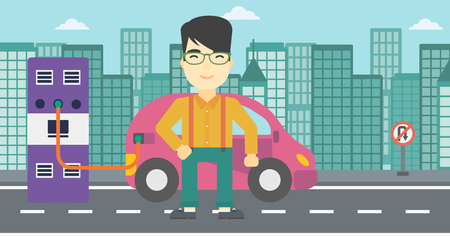1. Introduction: AI’s Role in Ride-Sharing and the Gig Economy
Artificial intelligence (AI) is transforming the way ride-sharing services and the gig economy operate. From optimizing routes to improving customer experiences, AI is becoming an essential part of these industries.
How AI Enhances Ride-Sharing Services
AI helps ride-sharing companies like Uber and Lyft improve their services in several ways:
| AI Feature | Impact on Ride-Sharing |
|---|---|
| Route Optimization | AI analyzes traffic data to find the fastest and most efficient routes. |
| Dynamic Pricing | AI adjusts pricing based on demand, ensuring rides are available when needed. |
| Safety Enhancements | AI detects unusual driving patterns to improve rider and driver safety. |
| Customer Support | Chatbots and AI-driven assistants help resolve customer inquiries quickly. |
The Gig Economy and AI Efficiency
AI also plays a critical role in other areas of the gig economy beyond ride-sharing:
- Optimizing delivery routes for food delivery services like DoorDash and Uber Eats.
- Matching freelancers with job opportunities based on skills and availability.
- Automating admin tasks, such as handling payments and scheduling work.
Why AI Matters for Drivers and Gig Workers
For drivers and gig workers, AI brings both benefits and challenges. While AI increases work efficiency and opportunities, it also impacts job security as automation continues to advance. As AI evolves, workers must adapt to new technologies to stay competitive in the gig economy.
2. AI-Powered Matching and Pricing Algorithms
Artificial intelligence plays a crucial role in optimizing ride-matching, surge pricing, and demand forecasting, making ride-sharing services more efficient for drivers and passengers alike. AI helps platforms like Uber and Lyft analyze real-time data to match riders with drivers more effectively, ensuring shorter wait times and maximizing driver earnings.
Smarter Ride-Matching
AI-powered algorithms consider multiple factors such as traffic conditions, driver location, rider preferences, and historical data to pair drivers with passengers quickly. Instead of relying solely on proximity, AI predicts optimal routes and reduces idle time for drivers, ultimately increasing efficiency.
Dynamic Pricing with Surge Algorithms
Surge pricing is a key feature of ride-sharing apps, ensuring there are enough drivers available during peak hours. AI dynamically adjusts prices based on real-time supply and demand data, encouraging more drivers to get on the road when demand spikes. Here’s how surge pricing works:
| Factor | Impact on Pricing |
|---|---|
| High rider demand | Increases prices to balance supply and demand |
| Low driver availability | Raises fares to attract more drivers |
| Special events or bad weather | Causes temporary surge fares |
Demand Forecasting for Better Earnings
AI analyzes historical ride data, seasonal trends, and ongoing events to predict future demand. This helps ride-sharing companies allocate resources efficiently and allows drivers to position themselves in high-demand areas. For instance, AI can forecast rush hour trends or major local events, helping drivers maximize their earnings by being in the right place at the right time.
Maximizing Efficiency for Everyone
By using AI-powered matching and pricing algorithms, ride-sharing platforms create a win-win situation for both passengers and drivers. Riders experience shorter wait times and smoother trips, while drivers benefit from optimized routes, better pricing, and increased ride opportunities. AI continues to refine these systems, making ride-sharing a more reliable and profitable aspect of the gig economy.

3. Enhancing Driver and Rider Safety
Safety is a major priority in the ride-sharing industry, and AI is playing a crucial role in making trips safer for both drivers and riders. From real-time monitoring to facial recognition and predictive risk analysis, AI-driven technology is transforming how safety is managed on the road.
Real-Time Monitoring
AI-powered real-time monitoring helps ensure that both drivers and passengers are safe during a ride. By using GPS tracking, sensor data, and machine learning algorithms, ride-sharing apps can detect unusual behavior, such as sudden stops, harsh braking, or erratic driving. If the system identifies potential dangers, it can send alerts to the driver, rider, or even emergency services when needed.
Facial Recognition for Secure Authentication
Facial recognition technology adds an extra layer of security by verifying driver and rider identities. Before starting a ride, drivers can be asked to take a quick selfie to confirm that they match their registered profile. This feature helps prevent unauthorized drivers from using a registered account, reducing the risk of fraud and improving rider trust.
Predictive Risk Analysis
AI algorithms can analyze vast amounts of data to predict potential risks before they happen. By examining driving history, weather conditions, traffic patterns, and even time of day, predictive models can assess the likelihood of an accident. If the system identifies high-risk situations, it can offer real-time safety recommendations or restrict certain high-risk trip requests. Below is a table highlighting some of the key factors AI considers in predictive risk analysis:
| Risk Factor | How AI Uses It |
|---|---|
| Driving Behavior | Detects harsh braking, sudden acceleration, and speeding |
| Weather Conditions | Analyzes rain, snow, or fog to adjust safety recommendations |
| Traffic and Road Conditions | Identifies accident-prone areas and heavy congestion |
| Time of Day | Recognizes late-night rides as higher risk for accidents or crime |
| Driver History | Evaluates past driving performance to assess risk levels |
Improving Trust and Security
By integrating these AI-driven safety features, ride-sharing platforms can provide a more secure experience for everyone. Riders feel more confident knowing that drivers are verified, and drivers benefit from tools that help them avoid risky situations. AI continues to evolve, making ride-sharing not only more efficient but also much safer for all parties involved.
4. Autonomous Vehicles and the Future of Ride-Sharing
Self-driving technology is transforming the ride-sharing industry in ways that could change how drivers, passengers, and ride-hailing companies operate. As autonomous vehicles (AVs) become more advanced, they are expected to play a bigger role in the gig economy, offering both opportunities and challenges.
How Self-Driving Vehicles Affect Ride-Share Drivers
For drivers, the rise of autonomous vehicles presents a significant shift in job opportunities. While self-driving fleets could reduce the demand for human drivers, new roles may emerge in areas like fleet maintenance, remote vehicle monitoring, and customer support.
Potential Changes in Job Opportunities
| Current Ride-Share Role | Possible Future Role |
|---|---|
| Driver | Fleet Supervisor |
| Customer Service | Remote Assistance Operator |
| Vehicle Maintenance | Autonomous Fleet Technician |
How Autonomous Vehicles Benefit Passengers
For passengers, self-driving technology could lead to lower ride costs, increased availability, and improved safety. With ride-sharing companies investing in AV technology, riders may have access to a more consistent and efficient transportation system.
Key Benefits for Ride-Share Passengers
- Reduced Costs: Without driver salaries, companies could charge lower fares.
- Greater Availability: AVs can operate 24/7, reducing wait times.
- Enhanced Safety: AI-driven vehicles have the potential to decrease human driving errors.
Challenges and Considerations
Despite the potential benefits, there are still challenges to consider. Regulations, public trust, and technological limitations might slow the adoption of AVs in ride-sharing services. Additionally, the transition could impact thousands of gig workers who rely on ride-sharing platforms for income.
Factors Affecting Autonomous Vehicle Adoption
- Regulation: Governments need to establish legal frameworks for AV operation.
- Technology Reliability: Self-driving systems must prove consistent safety and efficiency.
- Public Acceptance: Passengers need to trust autonomous vehicles before widespread adoption occurs.
As self-driving technology continues to evolve, it is changing not only how people get around but also how the gig economy functions. Whether autonomous ride-sharing becomes a seamless integration or faces major hurdles will depend on technological advancements, policy decisions, and public perception.
5. Challenges and Ethical Concerns
As AI transforms ride-sharing and the gig economy, it also brings significant challenges and ethical concerns. While automation and algorithms improve efficiency, they also create complications related to job stability, fairness, and data security.
Job Displacement
One of the biggest fears surrounding AI in the gig economy is job displacement. As companies introduce automation—including self-driving cars and AI-enhanced dispatching—many gig workers worry about their long-term job security.
| AI Development | Potential Impact on Gig Workers |
|---|---|
| Autonomous Vehicles | Could reduce demand for human drivers |
| AI-Based Customer Support | May replace human support agents |
| Automated Matching Algorithms | Could limit worker control over ride assignments |
Algorithmic Bias
AI systems rely on large datasets to make decisions, but if these datasets contain biases, the AI may reinforce unfair practices. This can lead to discrimination in pricing, ride assignments, and driver ratings.
Examples of Algorithmic Bias
- Unequal ride pricing for different neighborhoods
- Preference for certain types of drivers based on historical data
- Unfair deactivation of accounts based on flawed AI review processes
Data Privacy Concerns
Ride-sharing apps collect vast amounts of data, such as location history, trip preferences, and payment details. Protecting this data is critical, but AI-driven platforms sometimes raise concerns about data misuse or breaches.
Key Data Privacy Risks
- Tracking users locations without consent
- Sharing personal data with third parties
- Security vulnerabilities leading to data breaches
As AI continues to evolve in the ride-sharing and gig economy, addressing these challenges will be critical. Companies must implement ethical AI practices, ensuring fair treatment of gig workers while maintaining user privacy and trust.
6. Conclusion: What’s Next for AI in Ride-Sharing?
Artificial intelligence has already made a huge impact on ride-sharing and the gig economy, but this is just the beginning. As AI continues advancing, we can expect even more changes in how drivers, passengers, and ride-sharing companies interact.
AI’s Current Impact on Ride-Sharing
AI has dramatically improved the efficiency and convenience of ride-sharing through key innovations. Heres a look at some of the most significant areas where AI is making a difference:
| AI Technology | Impact on Ride-Sharing |
|---|---|
| Dynamic Pricing | Adjusts fares based on demand in real time |
| Route Optimization | Provides faster, more efficient routes for drivers |
| Safety Features | AI-powered monitoring helps detect unsafe driving behaviors |
| Customer Support Chatbots | Handles common rider and driver concerns instantly |
| Autonomous Vehicles | Self-driving technology has the potential to replace human drivers |
What the Future Holds
Looking ahead, AI will continue to reshape ride-sharing in several ways:
1. More Advanced Autonomous Vehicles
Driverless cars are expected to become a bigger part of ride-sharing. Companies like Waymo, Tesla, and Uber are already testing autonomous vehicles, which could eventually lead to lower fares and 24/7 availability.
2. Smarter Gig Work Management
AI-powered algorithms will likely continue optimizing work distribution, helping drivers maximize their efficiency and earnings while reducing downtime.
3. Improved Safety Measures
From AI dashcams that detect drowsy driving to predictive maintenance that prevents vehicle breakdowns, AI will make the ride-sharing experience safer for both drivers and passengers.
4. Personalization for Riders
AI could enhance the rider experience by offering more personalized recommendations, such as preferred routes, favorite drivers, or even music and climate control settings based on previous rides.
The Road Ahead
AI is set to bring even more efficiency and innovation to ride-sharing. While challenges like regulatory concerns and ethical considerations remain, one thing is certain: AI will continue to transform the gig economy, shaping the future of how people work and travel.

